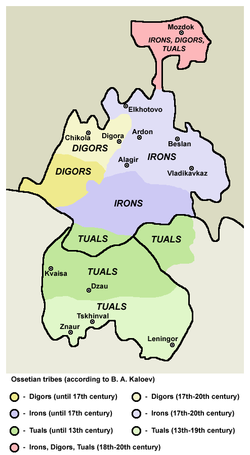Osetios
| Osetios ирæттæ | ||
|---|---|---|
 Mujeres osetias (siglo XIX) | ||
| Descendencia | 700 000 (aproximada) | |
| Idioma | osetio (nativo), ruso, georgiano | |
| Religión | Predominantemente cristianos ortodoxos con una minoría de musulmanes suníes. | |
| Etnias relacionadas | Pueblos iranios | |
| Asentamientos importantes | ||
| 515 000 |
| |
| 65 000 |
| |
| 38 028 |
| |
| 100 000 |
| |
| 400 |
| |

Los osetios, osetos u osetas (en osetio: ирæттæ, romanizado: irættæ) son pueblos iranios[1][2][3][4] un grupo étnico que viven principalmente en Osetia del Norte-Alania y Osetia del Sur. Los osetas son considerados como los últimos descendientes de los alanos y sármatas.[5]
Lengua
[editar]La lengua osetia pertenece a la familia de las lenguas indoeuropeas, dentro de esta, pertenece la rama de las lenguas iranias nordorientales. El osetio está dividido en dos dialectos principales, uno de los cuales es el ironio, hablado sobre todo en la parte oriental de Osetia del Norte, mientras que el otro dialecto, el digorio, se habla en la parte occidental de Osetia del Norte. Sin embargo, existen subdialectos del ironio, como el tualio hablado en la parte central de Osetia y el kudaro-djavio hablado en Osetia del Sur (considerado por algunos autores este último como un tercer dialecto). De todos los dialectos que posee esta lengua, el más hablado es el septentrional, es decir, el ironio, sobre el que se basa el lenguaje literario.
Dentro de las lenguas iranias, el osetio pertenece a la rama nororiental de estas lenguas. El osetio, junto con otra lengua, el yahnobi, hablado en el oeste de Tayikistán, es la única lengua superviviente de este subgrupo.
Véase también
[editar]Referencias
[editar]- ↑ Akiner, Shirin (2016) [1987]. Islamic Peoples of the Soviet Union. Routledge. p. 182. ISBN 978-0710301888. «The Ossetians are an Iranian people of the Caucasus.»
- ↑ Galiev, Anuar (2016). «Mythologization of History and the Invention of Tradition in Kazakhstan». Oriente Moderno 96 (1): 61. doi:10.1163/22138617-12340094. «The Ossetians are an East Iranian people, the Kalmyks and Buryats are Mongolian, and the Bashkirs are Turkic people.»
- ↑ Rayfield, Donald (2012). Edge of Empires: A History of Georgia. Reaktion Books. p. 8. ISBN 978-1780230702. «For most of Georgian history, those Ossetians (formerly Alanians, an Iranian people, remnants of the Scythians)...»
- ↑ Saul, Norman E. (2015). «Russo-Georgian War (2008)». Historical Dictionary of Russian and Soviet Foreign Policy. Rowman & Littlefield. p. 317. ISBN 978-1442244375. «The Ossetians are a people of Iranian descent in the Caucasus that uniquely occupy territories on both sides of the Caucasus Mountain chain.»
- ↑ «Ossetians». Encarta. Microsoft Corporation. 2008.
Text is available under the CC BY-SA 4.0 license; additional terms may apply.
Images, videos and audio are available under their respective licenses.
